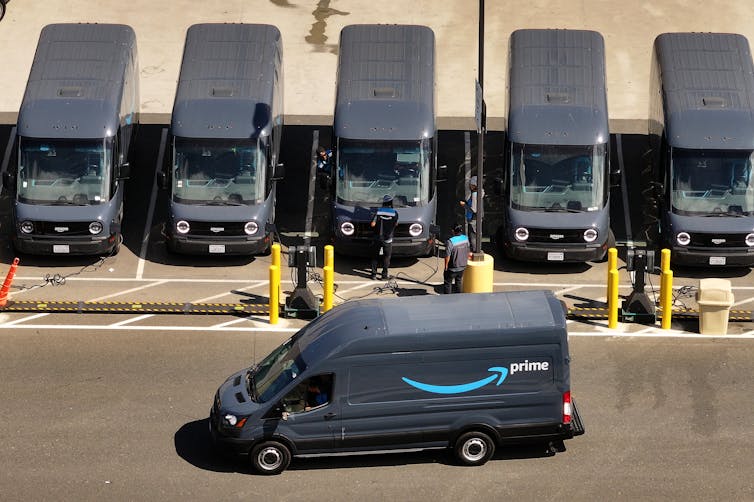Companies are still committing to net-zero emissions, even if it’s a bumpy road – here’s what the data show
- Written by L. Beril Toktay, Professor of Operations Management, Georgia Institute of Technology
 Companies are cutting emissions fastest from energy use. Falling solar prices help.CFOTO/Future Publishing via Getty Images
Companies are cutting emissions fastest from energy use. Falling solar prices help.CFOTO/Future Publishing via Getty ImagesCompanies around the world are increasingly committed to cutting their greenhouse gas emissions to slow and ultimately reverse climate change.
One indicator is the number of companies that have set emissions targets as part of the Science Based Targets initiative, or SBTi, a global nonprofit organization. That number grew from 164 companies in late 2018 to over 6,600 by November 2024. And thousands more have committed to lower their emissions.
It’s not always a smooth road, however. Some of those companies – including big names like Microsoft and Walmart – have had to pull back on some of their SBTi commitments.
We studythe historyof SBTi pledgesto understand these commitments and what can undermine them. We believe there is more to the story of these pullbacks than meets the eye.
What is net zero?
To understand corporate climate commitments, let’s start with the concept of “net zero.”
The Paris Agreement, an international treaty on climate change, aims to limit global warming to well below 2 degrees Celsius (3.6 Fahrenheit) and ideally to 1.5 C (2.7 F). Meeting the more ambitious target of 1.5 C will require reaching net-zero greenhouse gas emissions by around 2050.
Net zero is the point at which the amount of greenhouse gases released into the atmosphere is balanced by greenhouse gases removed, either through natural sources like forests or technologies such as carbon capture and storage.
The Science Based Targets initiative, developed alongside the Paris Agreement in 2015, provides a framework to help companies align their efforts with the 1.5 C goal.
SBTi commitments have grown quickly
To join the initiative, companies begin by signing a letter of commitment to set near-term (2030) and long-term (2050) targets for reducing their emissions. Companies have 24 months to develop targets that adhere to SBTi guidelines. If the targets are validated and approved by SBTi, the company announces its targets publicly. The targets must be revalidated every five years, or they expire.
The number of global companies committing to and setting targets with SBTi has grown rapidly in recent years.
By the end of 2023, 7,929 companies representing 39% of global market capitalization had committed to set targets, and 4,205 had targets already validated by SBTi. By November 2024, that number had grown to 6,614.
This impressive participation is particularly significant given SBTi’s high expectations. SBTi requires near-term targets to be set so companies reduce emissions by at least 42% by 2030 from 2020 levels.
Why some companies have pulled back
So, why are companies like, Walmart, Microsoft and Amazon scaling back their commitments with SBTi?
While some people attribute these moves to political pressure from fossil fuel supporters, a closer look at data since 2013 reveals a more complex set of factors that may better explain their actions.
We found that, over the past decade, 695 companies either withdrew near- or long-term commitments or had a commitment that expired and was terminated by SBTi. These actions were concentrated in two distinct periods.
The first period followed SBTi’s decision in April 2019 to update its criteria, including tightening the minimum target from under 2 C to either “well below 2 C” or 1.5 C. We believe several companies were unprepared to meet the new requirements. Among the 500 companies that had either committed to or set a target by the end of 2018, 94 (18.8%) terminated their initial commitments after the criteria changed.
The second period was after January 2023, when SBTi introduced a new compliance policy and began removing commitments that had expired. In this period, 531 commitments were terminated – 497 of them because the commitment expired, and 16 because the company withdrew.
It’s important to recognize that SBTi strategically raised the bar to encourage companies to accelerate their progress in addressing climate change.
Reasons some companies have struggled
In a report in March 2024, SBTi provided a candid look at companies’ climate commitments from 2019 to 2021 and, importantly, where they struggled.
Approximately half of the companies that responded to its survey identified the complexity of addressing Scope 3 emissions – emissions from a company’s supply chain and use of its products – as a primary obstacle to setting net-zero targets. The supply chain is often considered a blind spot for measuring environmental impact and is difficult for companies to control.
On the day the report was released, SBTi removed the long-term commitments of 239 companies. About 60% of those companies had near-term targets that remained.
 Amazon has more than 15,000 electric delivery vans on the road as part of its effort to cut its energy emissions. However, it has struggled with cutting emissions generated by its suppliers.Justin Sullivan/Getty Images
Amazon has more than 15,000 electric delivery vans on the road as part of its effort to cut its energy emissions. However, it has struggled with cutting emissions generated by its suppliers.Justin Sullivan/Getty ImagesThis helps explain the news around companies such as Walmart, Microsoft and Amazon.
Walmart’s and Microsoft’s long-term net-zero commitments were terminated, though both companies still have valid near-term targets with SBTi.
Moreover, both reaffirm their environmental commitments in their annual reports. Walmart is currently finalizing its Scope 3 emissions analysis to inform future strategy development, and Microsoft is investing in carbon removal technologies to become carbon-negative by 2030.
Amazon presents a more challenging case. The company may have faced difficulty meeting SBTi’s stringent mandate, particularly around supply chain emissions. Amazon has said it is still committed to reaching net-zero emissions and plans to explore setting targets with other organizations.
Many companies are on track
Our analysis of SBTi’s progress data, which includes all companies that had set a target by 2022 for which SBTi has emissions data, reveals that companies are cutting their emissions by a median annual rate of 5.4%.
Looking just at direct emissions from companies’ operations (Scope 1) and their purchased electricity (Scope 2), companies did even better. The median annual emissions decrease was 7.25% for companies with both Scope 1 and Scope 2 targets.
Scope 2 emissions are the low-hanging fruit and frequently align with cost-saving measures like improving energy efficiency.
Scope 3 emissions, those generated by companies’ suppliers and by consumer use of their products, are the biggest challenge. Companies with a separate Scope 3 target only reduced those emissions by a median annual rate of about 3%.
In 2024, SBTi announced plans to revise its Net-Zero Standard and allow companies to use carbon offsets to meet their Scope 3 emissions targets, drawing intense criticism. Carbon offsets allow companies to pay projects to reduce emissions on their behalf, such as by planting trees or managing forests.
SBTi’s challenge lies in finding a balance that maintains the integrity of its standards while encouraging broader participation, especially from high-impact industries.
Other ways companies are reducing emissions
While setting and achieving SBTi targets signals a strong commitment to combating climate change, many companies are setting emissions goals and working toward them without joining SBTi.
An example is the Drawdown Georgia Business Compact. It was created to accelerate the adoption of 20 technology- and market-ready solutions and includes nearly 70 companies, from multinationals headquartered in Georgia like Delta and UPS to small- and medium-size enterprises operating in the state.
Through the compact, companies are advancing initiatives with local economic benefits. For example, they are exploring ways to maximize Georgia forests’ ability to remove carbon and discussing effective ways to deploy sustainable aviation fuels.
The road to net-zero emissions will be bumpy. Yet the rapid growth of global corporate commitments, as well as action by a wider range of companies at the regional level, suggests corporate efforts are nevertheless moving forward.
L. Beril Toktay is Regents' Professor in the Georgia Tech Scheller College of Business and Faculty Director of the Ray C. Anderson Center for Sustainable Business. The Center facilitates the Drawdown Georgia Business Compact, whose operations are in part funded by corporate gifts from Compact members.
Abhinav Shubham, Donghyun (Daniel) Choi, and Manpreet S. Hora do not work for, consult, own shares in or receive funding from any company or organization that would benefit from this article, and have disclosed no relevant affiliations beyond their academic appointment.
Authors: L. Beril Toktay, Professor of Operations Management, Georgia Institute of Technology

